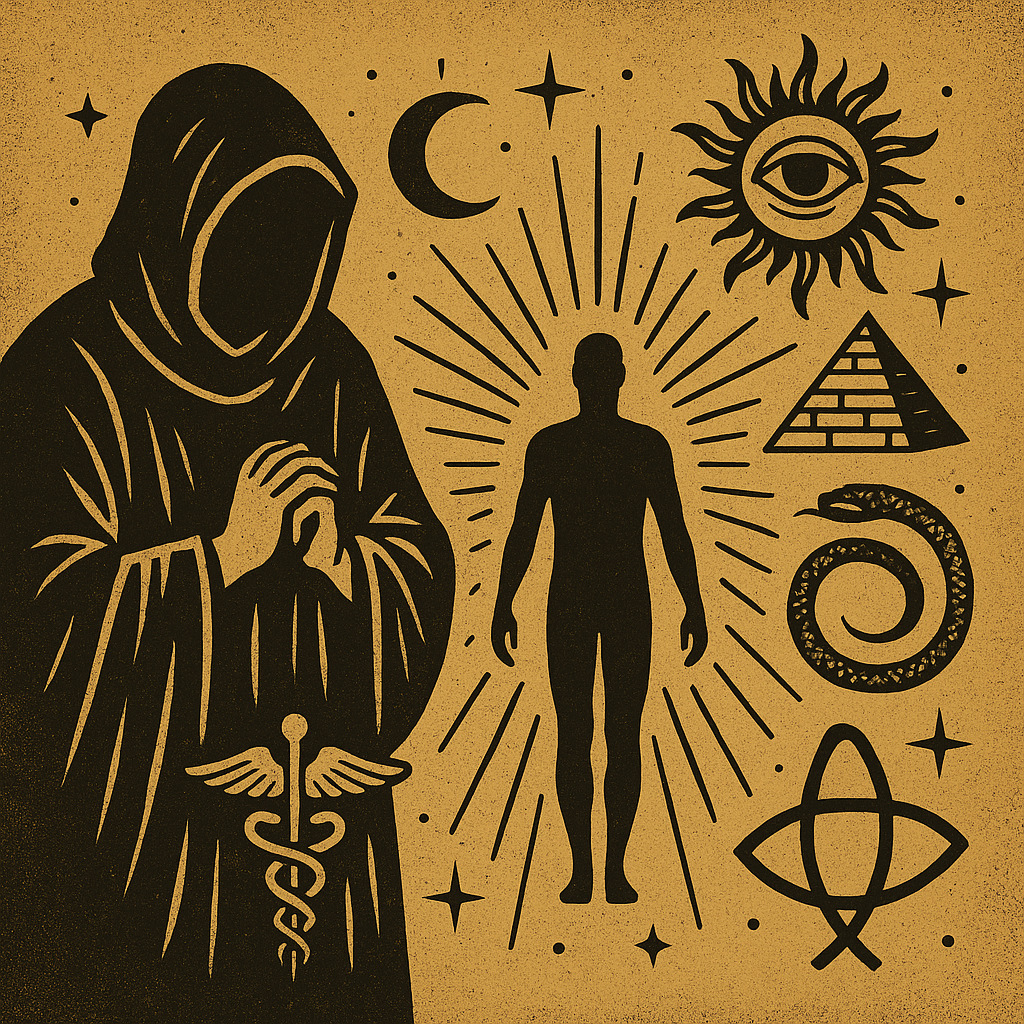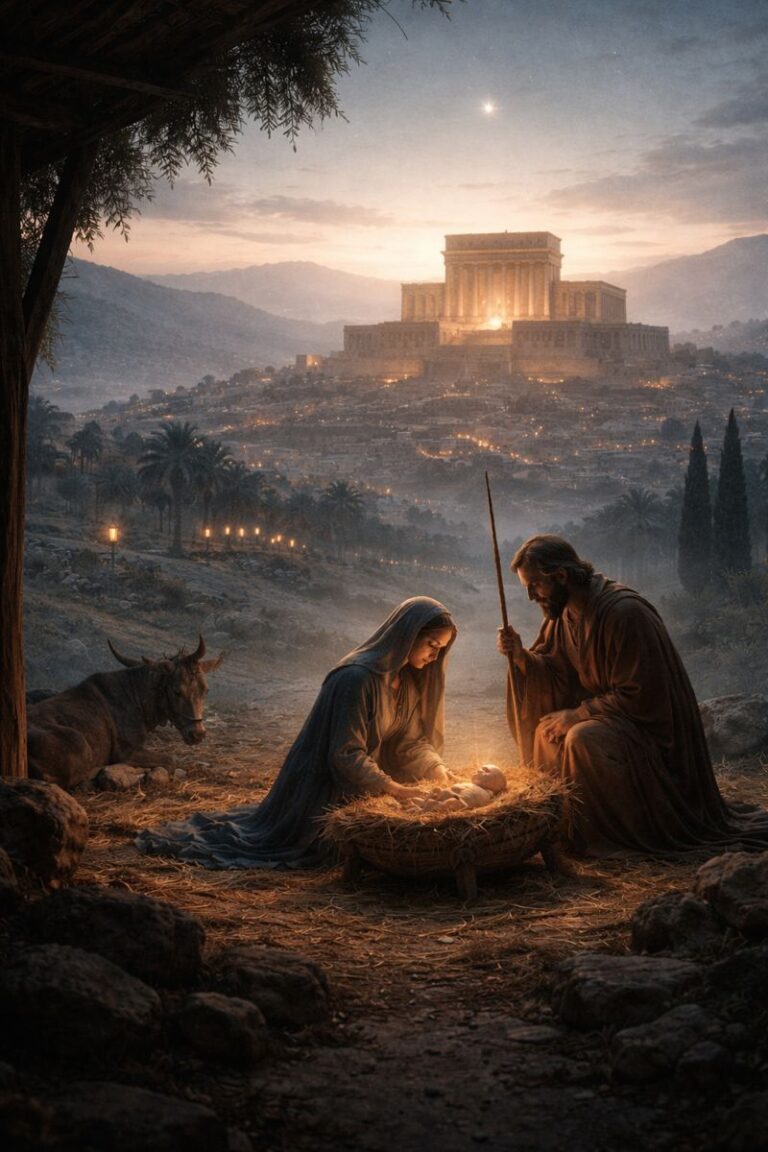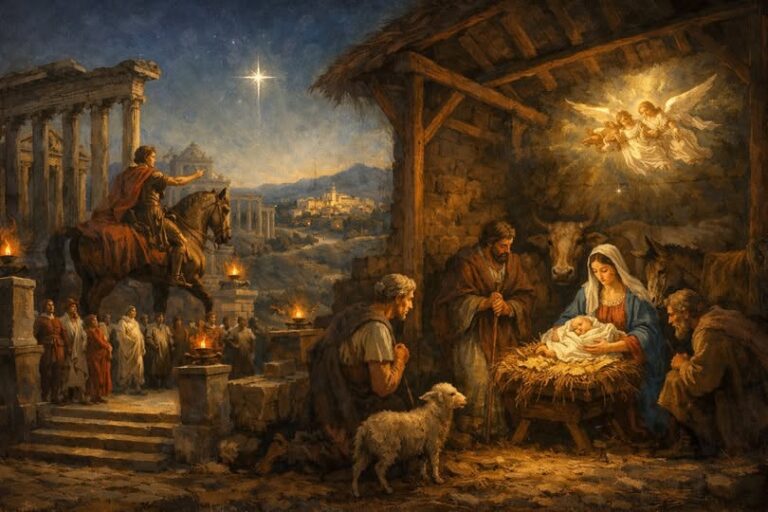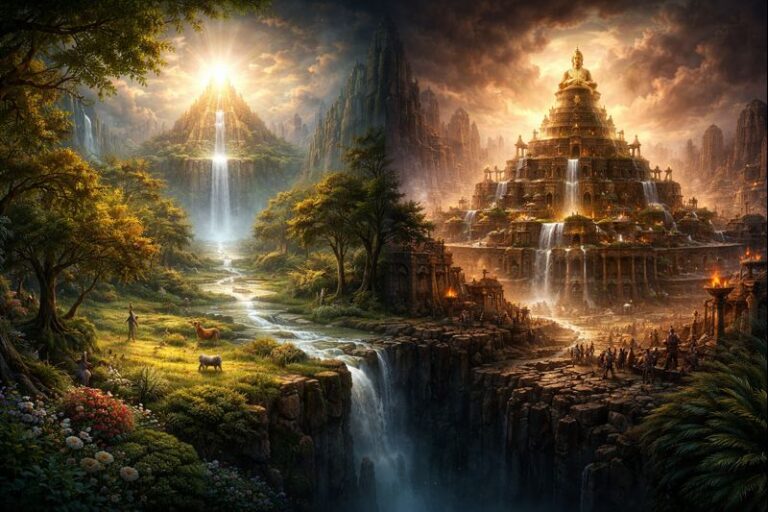
The Eastern Orthodox Church preserves one of the most profound teachings of Christianity: theosis, or deification. This doctrine is not about erasing the line between Creator and creation but about God drawing humanity into His own life. Through Christ’s incarnation, death, and resurrection, believers become partakers of the divine nature, not by nature but by grace. Athanasius expressed it clearly: “God became man so that man might become god.” By this, the Fathers never meant that humanity becomes equal to Yahweh in essence. Rather, theosis means that through grace we are healed, restored, and glorified in Christ, sharing in His life while always remaining His creatures.
The Counterfeit in Eden
The serpent in Eden also offered a form of deification. His words, “You will be like gods,” suggested that humanity could seize by rebellion what God intended to give through communion. The Eastern Orthodox vision of theosis fulfills God’s purpose, while the serpent’s promise distorts it. Throughout history, this distortion has reappeared in many guises, most notably in Hermeticism and Gnosticism.
Echoes of Antediluvian Rebellion
Many occult systems, whether ancient mystery religions or modern esoteric revivals, could have drawn their perceived legitimacy from the idea that they recover lost knowledge from before the Flood. Traditions surrounding the Watchers, the Apkallu, or figures like Prometheus all involve heavenly beings imparting forbidden wisdom to humanity in defiance of divine boundaries. This knowledge, which included arts, sciences, and sorcery, was not neutral. It was given with the intent to corrupt and destroy.
After the Flood, while the physical giants perished, their spirits, what later literature calls demons, remained. These disembodied spirits could have been the source of insight or inspiration for occult practitioners throughout history, masquerading as guides to hidden wisdom while promoting rebellion against God. Whether through direct contact or mythic lineage, many esoteric movements trace their roots back to this primeval transgression.
Hermeticism: Optimistic Gnosis
The Corpus Hermeticum, composed in the early centuries of the Christian era, fused Egyptian religion with Greek philosophy. It taught that humans contain a divine spark that can be awakened through hidden wisdom. Salvation came not through God’s grace but through gnosis, mystical ascent, and the realization of one’s innate divinity. Unlike Gnosticism, Hermeticism viewed the cosmos more positively, as a reflection of divine order, but its end goal was the same: erasing the line between Creator and creation.
Gnosticism: Dualistic Gnosis
Gnosticism developed in the same cultural environment and shared Hermeticism’s focus on hidden wisdom and the divine spark in man. But it was far more pessimistic. Many Gnostic systems taught that the material world was a prison fashioned by a false or ignorant creator, the Demiurge. Salvation meant escaping matter entirely and returning to the realm of spirit. Its texts, like the Apocryphon of John or the Gospel of Thomas, presented elaborate myths of aeons, archons, and cosmic struggles that reframed rebellion as enlightenment.
Parallel Streams of Corruption
Though different in tone, Hermeticism optimistic and Gnosticism pessimistic, both traditions proclaimed salvation by gnosis. Both claimed man was divine by nature. Both promised deification apart from Christ. And both blurred or destroyed the Creator–creature distinction. Where Orthodoxy taught communion by grace, Hermeticism and Gnosticism promised exaltation by hidden knowledge.
Renaissance Rediscovery and Transmission
In the Renaissance, Hermetic and Gnostic writings were rediscovered and hailed as the prisca theologia, a supposed universal truth older than Moses. Figures like Marsilio Ficino and Pico della Mirandola embraced these texts as revelations of timeless wisdom. Their influence spread through alchemy, astrology, and ritual magic, setting the stage for later esoteric societies. Hermetic optimism and Gnostic dualism together nourished the roots of Western occultism.
Freemasonry
Freemasonry grew out of the esoteric ferment of the Renaissance and Enlightenment, which were themselves shaped by the rediscovery of the Hermetic and Gnostic writings. While the fraternity presents itself publicly as a system of moral improvement and brotherhood, its inner symbolism and ritual language reveal a strong dependence on Hermetic and alchemical traditions. The Masonic use of sacred geometry, the emphasis on hidden degrees of initiation, and the maxim “as above, so below” all trace back to the Corpus Hermeticum and related Hermetic texts.
The Renaissance had already reintroduced these ideas into European culture, presenting Hermeticism and Gnosticism as prisca theologia, a supposed ancient wisdom that underlay all religions. These concepts filtered into Rosicrucian manifestos in the seventeenth century, which combined mystical Christianity with alchemy and Hermetic philosophy. Rosicrucian influence, in turn, fed directly into the development of modern Freemasonry in the eighteenth century. The lodge thus became an heir to the Hermetic worldview, reframing gnosis not in overtly pagan terms but as moral allegory and ritual drama.
Freemasonry’s initiation system reflects the Gnostic idea that truth is revealed progressively to an inner circle of the enlightened. The candidate begins in ignorance, is symbolically “raised” to new life, and ascends through degrees of increasing illumination. The rituals employ veiled symbols and allegories rather than explicit teaching, echoing the Hermetic conviction that divine truths must be concealed from the unworthy and revealed only to initiates. This places Freemasonry in continuity with both Hermetic mysteries and Gnostic elitism.
Although Freemasonry claims to honor God, it deliberately leaves the identity of God undefined. Its universalist ethos allows men of any faith to participate, so long as they acknowledge a Supreme Being. This broad inclusivity is not biblical covenantal faith but a continuation of Hermetic universalism, which treated all religions as partial reflections of a hidden wisdom tradition. By blending fragments of biblical language with Hermetic symbols and Gnostic structures, Freemasonry offers a path of human self-perfection and enlightenment apart from Christ.
Mormonism
Mormonism reflects both the Hermetic worldview and Masonic ritual structure. Long before Joseph Smith entered a Masonic lodge in Nauvoo, he was already immersed in practices rooted in Hermetic and occult traditions. In his youth, Smith participated in treasure-seeking expeditions using a divining rod, seer stones, and ritual circles. These tools and practices were drawn from the folk-magic culture of early America, which itself was saturated with ideas that had filtered down from Renaissance Hermeticism and alchemical traditions. The belief that hidden knowledge could be accessed through special instruments, secret formulas, and visionary techniques fits neatly within the Hermetic framework of unlocking the unseen world.
When Smith later became a Mason in 1842, he layered these Hermetic practices with Masonic structures. Within weeks of his initiation, he introduced LDS temple ceremonies that bore striking resemblances to Masonic rituals, including secret handshakes, symbolic clothing, and oaths of secrecy. Just as Freemasonry framed its degrees as progressive revelations of hidden wisdom, so too did Smith present Mormon temple ordinances as the means by which believers gained access to the mysteries of exaltation.
Doctrinally, Mormonism’s teaching of eternal progression mirrors the Hermetic promise of apotheosis. God the Father is said to have been a man who became a god, and faithful men may follow the same path. This collapses the biblical distinction between Creator and creature and transforms salvation into a process of exaltation through hidden rites and teachings. The Mormon vision of countless gods presiding over countless worlds echoes the multiplicity of divine beings in Hermetic and Gnostic systems, while its temple ceremonies function as initiatory mysteries in which knowledge is revealed step by step.
From his earliest magical experiments with seer stones to the institutionalization of Masonic-style temple rites, Smith drew deeply from the Hermetic stream. Mormonism is thus not only structurally indebted to Freemasonry but also conceptually indebted to Hermeticism and Gnosticism, making it one of the clearest examples of how these counterfeit traditions reshaped religious life in the modern era.
New Thought
The New Thought movement arose in the 19th century in America, drawing on Transcendentalism, Mesmerism, and the same Hermetic and Gnostic currents that influenced Mormonism and Spiritualism. Figures like Phineas Quimby and later teachers such as Ralph Waldo Trine, Emma Curtis Hopkins, and Charles Fillmore (co-founder of Unity) taught that the mind itself could shape reality. By aligning thoughts with divine principles, one could attract health, wealth, and success.
This conviction, that thought is a spiritual force, echoes Hermeticism’s doctrine of correspondences and the Gnostic emphasis on hidden, inner knowledge. Just as Hermetic texts taught that the human mind was a fragment of the divine Mind, New Thought proclaimed that human consciousness could tap into the creative power of God. The result was a system of practical mysticism in which salvation became health, prosperity, and self-realization.
New Thought retained Hermetic universalism, claiming that all religions were partial expressions of the same truth. It also perpetuated the counterfeit of theosis: man is not redeemed by grace through Christ but awakens to his own divine potential. This is the same deception reframed for a modern, optimistic, American audience.
The influence of New Thought has been enormous. It provided the soil for the modern Prosperity Gospel in Christianity, with its focus on positive confession and faith as a force. It also laid much of the groundwork for New Age spirituality, especially in the popularization of concepts like “manifesting,” “positive energy,” and “the law of attraction.” In every case, the biblical promise of transformation through Christ was displaced by a Hermetic promise of transformation through mental mastery and spiritual technique.
The New Age Movement
The New Age movement represents the modern expression of the same Hermetic and Gnostic worldview, repackaged for a mass audience in the twentieth century. What Hermetic texts once reserved for initiates, the New Age popularized as a spiritual marketplace of ideas, promising enlightenment to anyone willing to explore hidden wisdom. At its core, the New Age teaches that humanity possesses a divine spark, that all religions point to the same truth, and that salvation comes through awakening to our own latent godhood.
One of the clearest examples of this corruption is astrology. In Scripture, the heavens were created by God to mark times and seasons and to declare His glory (Genesis 1:14, Psalm 19). The Magi who recognized the star at Christ’s birth show the legitimate use of the heavens under God’s direction. But Hermeticism twisted this, turning the stars into tools for divination and personal destiny. That corrupted astrology—horoscopes, zodiac predictions, and magical correspondences—was passed into Western occultism and eventually absorbed by the New Age. When modern seekers use horoscopes to shape their lives or divine their future, they are practicing the Hermetic corruption rather than the biblical testimony of the heavens.
Energy healing and the belief in subtle forces within the body likewise echo Hermetic and Gnostic teachings about the cosmos as a living organism infused with divine power, where hidden correspondences bind the physical and spiritual realms together. Channeling spirits and ascended masters repeats the Gnostic idea of higher beings revealing secret knowledge to a spiritual elite, now democratized for seekers eager to receive messages from beyond. Meditation techniques that promise union with the divine self mirror Hermetic ascent narratives, where the initiate rises through the spheres to return to the cosmic Mind.
The New Age also absorbs the universalist ethos of Hermeticism, insisting that no one path is exclusive and that all religions are fragments of a greater truth. This is a direct inversion of biblical covenant faith, which anchors salvation in Christ alone. By flattening distinctions between the holy and the profane, the New Age mirrors the Gnostic tendency to redefine rebellion as enlightenment.
In every respect, the New Age represents the same counterfeit of theosis. It offers divinity without Yahweh, knowledge without revelation, and spiritual ascent without the cross. Though it dresses itself in modern language and practices, its DNA is unmistakably Hermetic and Gnostic.
The Common Thread
Orthodox theosis is union with Christ, by grace, through the Spirit, preserving the uniqueness of the Creator and the dependence of the creature. Hermeticism, Gnosticism, Freemasonry, Mormonism, New Thought, and the New Age all present counterfeits. They promise godhood without God, knowledge without grace, and exaltation without the cross. They recycle the ancient lie of Eden in new languages, whether the myth of the Demiurge, the allegories of the Corpus Hermeticum, the rituals of the lodge, the progression of the LDS temple, the affirmations of New Thought, or the spirituality of the New Age.
Conclusion
The true promise of deification is fulfilled only in Christ, who heals, restores, and glorifies His people through His life, death, and resurrection. The counterfeit promises remain alluring, but they cannot save. Theosis leads to eternal communion with the Triune God. Hermeticism, Gnosticism, and their heirs lead only back to Eden’s deception, where man reaches for godhood apart from grace and finds only ruin.
Discussion Questions
- How does Orthodox theosis differ from the serpent’s promise in Eden, and why is it important to keep that distinction clear?
- In what ways do Hermeticism and Gnosticism blur the boundary between Creator and creation, and how does that contrast with biblical teaching?
- How do the practices of Freemasonry, Mormonism, New Thought, and the New Age each reflect Hermetic and Gnostic roots?
- Why is it significant to distinguish between the legitimate biblical use of the heavens and the corrupted astrology found in Hermeticism and the New Age?
- What practical steps can Christians take to recognize and resist modern counterfeits of theosis that promise divinity without God and knowledge without grace?
Want to Know More?
- Athanasius, On the Incarnation
Classic work of the early Church Fathers, explaining why the Word became flesh and how this relates to theosis. - Vladimir Lossky, The Mystical Theology of the Eastern Church
A clear presentation of Orthodox teaching on theosis, stressing the Creator–creature distinction and union with God by grace. - Michael S. Heiser, The Unseen Realm
Explores the biblical supernatural worldview, including the fall of the heavenly host and how counterfeit spiritual systems emerge. - Richard L. Bushman, Joseph Smith: Rough Stone Rolling
A definitive biography of Joseph Smith, providing insight into his use of seer stones, folk-magic, and his connection to Freemasonry in shaping Mormon doctrine. - Charles S. Braden, Spirits in Rebellion: The Rise and Development of New Thought
A careful study of New Thought, its origins in Phineas Quimby, and its influence on American spirituality, prosperity teaching, and self-divinization. - Wouter J. Hanegraaff, New Age Religion and Western Culture
Examines how Hermeticism and Gnosticism were repackaged for a modern audience through New Age practices such as astrology, channeling, and energy healing. - Albert G. Mackey, The Symbolism of Freemasonry
A classic examination of Masonic ritual and symbolism, revealing its Hermetic and esoteric underpinnings and showing why it departs from biblical truth.




